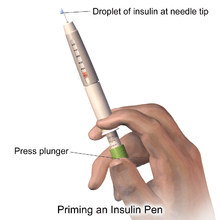Insulin pen
An insulin pen is used to inject insulin for the treatment of diabetes. Insulin is a hormone produced by the pancreas. It is composed of an insulin cartridge (integrated or bought separately) and a dial to measure the dose, and is used with disposable pen needles to deliver the dose. It was introduced and marketed as NovoPen by the Danish company Novo Nordisk in 1985.
Types of pens
A number of companies make insulin pens including Novo Nordisk, Aventis, Eli Lilly and Biocon. These companies produce pens for most of their insulins, including NovoLog/NovoRapid, Humalog, Levemir and Lantus.
There are two pen systems: durable and prefilled:
- A durable pen uses a replaceable insulin cartridge. When the insulin cartridge is empty, the empty cartridge is disposed of and a new one is inserted in the pen.
- A prefilled pen is entirely disposable. The pen comes pre-filled with insulin, and when the insulin cartridge or reservoir is empty, the entire unit is discarded.
Most brands of insulin are now available for use in pens, these include:
Global Patient Uptake
Insulin pens are used by over 95% of insulin-treated patients in Europe, Asia, Australia and Scandinavia with excellent results.[1] They are currently underutilized but growing in use in the United States.
Insulin pens offer several significant advantages over insulin syringes: ease of handling, accuracy, and they are more discreet to use and easier to transport.
To use an insulin pen

- Screw or click on a new pen needle.
- If necessary, prime the pen to remove any air from the needle
- Turn the knob on the end of the pen (or "dial") to the number of units needed
- Insert the needle into the skin
- Press the button on the end of the pen to deliver the dose
- Count to five or ten depending on dose injected
- Remove
- Remove used pen needle for disposal
Advantages
Insulin pens have a number of advantages:
- More convenient and easier to transport than traditional vial and syringe
- Repeatedly more accurate dosages
- Easier to use for those with visual or fine motor skills impairments
- Less injection pain (as polished and coated needles are not dulled by insertion into a vial of insulin before a second insertion into the skin)
It is important that proper injection sites on the body be used. A healthcare provider helps determine the best injection site for a patient. In general, recommended injection sites include the abdomen, parts of the buttocks, parts of the upper arms and thigh areas.[2]
Disadvantages
Unlike with the traditional syringe, two different insulins cannot be mixed by the user in an insulin pen.[3] On the other hand, some of the newest types of insulin cannot be mixed at all. In addition, using pens and pen needles is usually more expensive than using the traditional vial and syringe method; insurance coverage for insulin pens in the United States may vary widely, however in the UK insulin dependent diabetics are given pens for free as part of the NHS.
Additional images
 Illustration of Insulin Pen and Syringe
Illustration of Insulin Pen and Syringe
See also
- Insulin pump
- Insulin syringe
- Insulin port
- Injection port
- Pen needles
References
- Taking Control of Your Diabetes: Education, Motivation, Self-Advocacy by Steven V. Edelman, MD and Friends Archived 2008-09-07 at the Wayback Machine
- Injection Techniques & Tips
- Diabetes Insulin Pen Archived 2007-12-09 at the Wayback Machine